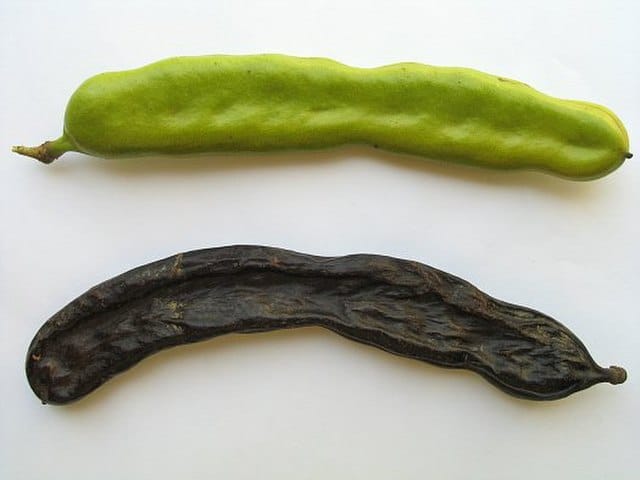Algarrobo:
What is it?, history, cultivation, nutritional value, uses, recipes, and more...
The algarrobo, or Prosopis pallida, is a South American tree that has been providing multiple benefits to the people of Peru since ancient times, thanks to its qualities as food and raw material for various economic and productive activities. Its most well-known product is algarrobina.
Índice
What is the Algarrobo?
The algarrobo is a tree that can reach heights of 8 to 20 meters. It has two distinct types of roots: one or two taproots that can extend up to 60 meters deep, allowing it to access water at different depths, and lateral roots that extend up to 60 meters above the surface at a depth of 15 to 25 cm.
Its trunk is irregular, twisted, and knotty, with a diameter ranging from 80 cm to 2 meters. Its crown is usually very wide, exceeding 15 meters in diameter, with an umbrella-like shape, whimsical branches, and abundant evergreen foliage. In some cases, it has hanging branches that reach the ground.
The outer bark of the algarrobo is brownish-gray to blackish, fissured, woody, and occasionally spiny. The inner bark is white and red, with a varnish-like smell and fibrous texture.
The leaves are evergreen and compound, with relatively short petioles and elliptical leaflets that have smooth edges and a central vein on the underside. The flowers grow in long axillary spikes, are small, pale yellow, pubescent, with a bell-shaped calyx and a corolla with five separate petals.
The fruits of this plant, also known as algarrobo pods, are sweet and fleshy pods that measure between 10 and 30 cm in length, 1 to 1.5 cm in width, and 5 to 9 mm in thickness. Each pod contains 20 to 30 grayish or brownish ovoid-shaped seeds.
History of the Algarrobo
The algarrobo is a native plant species of Peru, Colombia, and Ecuador that grows in the driest parts of these countries along the Pacific coast.
During the colonial era, the Spanish noticed similarities between the “European carob tree” (Ceratonia siliqua) and the “tacco” as the Prosopis pallida was known in Quechua, which led them to use the same name for it.
In the 19th century, the renowned researcher Antonio Raymondi discovered pre-Columbian wooden idols carved in the shape of the “algarrobo,” suggesting that this plant was already known and utilized since pre-Hispanic times.
The algarrobo was introduced to Puerto Rico and Hawaii, where it is now considered naturalized. The first algarrobo tree was planted in Hawaii in 1828, and by 2006, it had become a common shade tree throughout the area and an invasive species in the Hawaiian islands.

Common name of Algarrobo
| Español | huarango, algarrobo pálido, kiawe, bayahonda o algarroba |
| Quechua | Tacco |
| Francés | Caroube |
| Inglés | Carob |
| Alemán | Karob, karuben |
| Italiano | caruba |
Scientific name of Algarrobo
Prosopis pallida
Taxonomy of Algarrobo
| Reino | Plantae |
| División | Fanerógama Magnoliophyta |
| Clase | Dicotiledónea Magnoliopsida |
| Orden | Fabales |
| Familia | Fabaceae |
| Subfamilia | Mimosoideae |
| Tribu | Mimoseae |
| Género | Prosopis |
| Especie | P. pallida (Humb. & Bonpl. ex Willd.) Kunth |
Synonymy of Algarrobo
Acacia pallida Humb. & Bonpl. ex Willd.
Mimosa pallida (Humb. & Bonpl. ex Willd.) Poir.
Prosopis limensis Benth
Etymology of Algarrobo
Prosopis: Generic name given in Greek for the burdock, but it is unknown why it is applied to this plant.
Pallida: Latin epithet meaning “pale.”
Algarrobo: According to the RAE (Royal Spanish Academy), it is a term that comes from Arabic “alẖarrúba,” which in turn derives from classical Arabic “ẖarrūbah” or “ẖarnūbah,” and this from Persian “ẖar lup” meaning ‘donkey’s jaw’. Upon arriving in America, the Spanish observed some similarities between this tree and the “European algarrobo” (Ceratonia siliqua), which is why they named it similarly.
Habitat of the Algarrobo
- Habitat
The algarrobo tree is native to northern Peru, Colombia, and Ecuador, but it has also adapted to other regions in the Americas. It grows wild in the northern coastal regions of Peru up to 1,500 meters above sea level. In areas with droughts and infertile soil, it develops as a shrub.
Under suitable conditions, the algarrobo requires at least eight hours of sunlight per day to flower and bear fruit, typically occurring between October and April in Peru.
This plant thrives with an average annual precipitation of 250 to 500 mm, ranging from sea level up to 1,500 meters above sea level. However, the best specimens are found between 50 and 400 meters above sea level.
It's important to note that temperatures below 5ºC can cause the algarrobo to die due to sap circulation paralysis, while it easily tolerates high temperatures. During summer, it can withstand up to 45ºC.
The algarrobo tree grows in flat or undulating areas. It prefers sandy-loamy and clayey-sandy soils with a neutral pH and can even develop in saline soils. It's a species that tolerates long periods of drought.
Under suitable conditions, fruit production can begin as early as the 3rd year, but abundant flowering is typically achieved from the 7th year onwards. Vegetative propagation through cuttings can be done from 18 months of age.
For planting, either the whole fruit, segments of the fruit, or individual seeds can be used. However, the germination rate is usually low. To extract the seeds, the fruit's outer covering (exocarp and mesocarp) can be soaked for 14 days, or freshly harvested fruits can be placed in sealed bags to allow the mesocarp to decompose through fungal action. Alternatively, fermentation with manure for 14 days can be performed, after which the mesocarp can be easily removed by washing, leaving the seeds in the endocarp. Mechanical removal of the mesocarp is also possible but usually more labor-intensive. The endocarp can be removed by soaking the fruits in a slightly acidic or alkaline solution (e.g., 4% NaOH) and subsequent mechanical treatment.
Geographical distribution of Algarrobo

Piura and Lambayeque
Seasonal Availability of Algarrobo
- January, February, July, August, December
Varieties of Algarrobo
Prosopis pallida is morphologically highly variable. Due to self-incompatibility, obligatory cross-pollination, and environmental factors, mainly climatic, it exhibits high phenotypic variability. Additionally, some authors recognize the existence of infraspecific taxa. In Peru, algarrobo is used from wild populations, and there is no information available on variety and/or clone selection practices.
Nutritional Value of Algarrobo
Algarrobo is a legume with high nutritional content. It is rich in fiber, glucose, fructose, and sucrose. It also contains carbohydrates, minerals such as potassium, iron, zinc, iodine, selenium, and calcium, and in lower concentrations, macrominerals like phosphorus and magnesium. It provides a high content of vitamins from the B complex (B1, B2, B3, B6, and B9), C, and E, as well as important fatty acids.
Its nutrients balance the blood pH and, being an energizing food, benefit the proper functioning of the immune system to protect the body and mitigate the impact of various diseases.
Similarly, it can be considered a good source of amino acids, as it contains all seven essential types (threonine, methionine, valine, isoleucine, leucine, phenylalanine, and lysine) in concentrations that meet WHO standards.
Health Benefits of Algarrobo
Algarrobo is rich in proteins and fats, and the husk is rich in fiber.
Contraindications or Side Effects
Although algarrobo is a highly recommended and healthy pod, it should not be consumed in excess, as excessive consumption over long periods can reduce the absorption of nutrients such as iron or proteins.
| 10 Porciones por Kilogramo | |
| Tamaño de porción | 100g |
| Cantidad por porción Calorías |
340 |
| Cantidad por 100g | |
| Energía | 1,423 kJ |
| Grasa Total | 3.2 g |
| Sodio | ● |
| Carbohidratos totales | 65.8 g |
| Carbohidratos disponibles | ● |
| Fibra Dietaria | ● |
| Proteínas | 12.0 g |
| Calcio | 450 mg |
| Fósforo | 617 mg |
| Zinc | ● |
| Hierro | 6.60 mg |
| Potasio | ● |
| Agua | 12.5 g |
| Cenizas | 6.5 g |
| Vitamina A | ● |
| Tiamina (B1) | 0.18 mg |
| Riboflavina (B2) | 0.29 mg |
| Niacina (B3) | 2.50 mg |
| Vitamina C | ● |
| Acido Fólico (B9) | ● |
| β-Caroteno | ● |
| Fuente: Tablas peruanas de composición de alimentos – Centro Nacional de Alimentación y Nutrición – Ministerio de Salud – Perú | |
Derived Products and Consumption Forms of Algarrobo
Uses of Algarrobo
One of the main uses of algarrobo is industrial, thanks to its multiple qualities as food, fodder, fertilizer, charcoal, wood, medicine, and raw material for various economic-productive activities. Its ancestral medicinal use and its use in local gastronomy are also notable.
- Culinary
- Medicinal
- Industrial
Culinary use of Algarrobo
From the fruits of the algarrobo, algarrobina, champús, wines, chicha, carob tea, flour for baking, sweets, flavorings, sweeteners, ice creams, algarroba mazamorra, among many other foods, are obtained. Its seeds are used to make coffee, alcohol, herbal medicines, etc.
Algarrobina is the most well-known and appreciated food based on algarrobo. Algarrobina is a concentrate of carob pods, slightly viscous and astringent in taste, which is widely used in gastronomy, especially in the preparation of juices, cocktails, and desserts. This syrup also stands out for its medicinal properties as an energizer and for preventing anemia, among other benefits.
Algarrobo is also known for its use as a thickener and gelling agent, commonly used in sauces, creams, and the production of ice creams and similar desserts, as it prevents the formation of crystals and provides a stable and creamy texture.
In Piura, a northern department of Peru, various products based on algarrobo, such as bee honey, milk toffee with algarrobina, algarroba flour, and coffee, have been produced.
Medicinal use of Algarrobo
Algarrobo possesses multiple medicinal qualities and is considered a powerful natural tonic.
Its bark is astringent and contains tannins, which have antioxidant and protective properties. It is also valued as a hemostatic agent that stops and prevents bleeding.
The resin is especially indicated for combating asthma, gonorrhea, cystitis, laryngitis, indigestion, and serves as an excellent expectorant.
The sap is used in the treatment of oral ulcers.
Its leaves are used in poultices due to their anti-inflammatory properties and are applied in cases of muscular pain, bruises, or bone pain caused by falls.
Algarrobo honey has relaxing properties, is highly energetic, regulates acid secretion in the stomach, and is beneficial for preventing bronchial ailments.
The pulp has astringent and antidiarrheal properties, and it absorbs toxins from the digestive tract, making it excellent for treating childhood diarrhea and alleviating stomach discomfort.
Due to its high fiber content (pectin and lignin), algarrobo has a particular effect on the intestinal flora, reducing bacteria and increasing lactobacillus. Pectin also has coagulating and bactericidal properties, prevents cancer, reduces cholesterol, helps in the formation of cell membranes, eliminates heavy metals and radioactive substances from the body, and protects the intestinal mucosa.
When the algarrobo is green, it acts as a laxative. To reap its benefits, the legume should be consumed raw. It can be blended and mixed with other ingredients to mask the taste.
Additionally, alcohol and other natural medicines are obtained from its seeds. These seeds are considered a galactagogue product that increases milk secretion.
Algarrobina, its star product, is a honey that serves as a natural energizer, rich in protein, and in high demand for combating anemia and malnutrition, as well as improving the nutrition of athletes, pregnant women, children, and the elderly.
Industrial use of Algarrobo
Algarrobo is used in various industrial products. One of the most commercialized is algarrobina, an energetic syrup made from this plant.
The flowers of the algarrobo are an excellent resource for beekeeping, used in the production of honey, jelly, pollen, and wax. The foliage resulting from the defoliation process is used as excellent fodder for mainly sheep and goat livestock. The fruits (pods), due to their nutritional characteristics and taste, are also used as animal feed for cattle, goats, sheep, horses, and other domestic animals, sometimes replacing corn and wheat bran in their diet.
Algarrobo also has very hard wood, making it attractive for consumption as firewood and charcoal. It is also used in the construction of furniture, parquet flooring, agricultural property fences, doors, tables, beams, among others. The bark of the trunk is used for tanning leather, and its resin is used for dyeing.
Additionally, the dried fallen leaves, when decomposed, are used as organic fertilizer in various crops and are currently used in agroforestry systems as windbreaks, also providing shade for livestock.
The carob gum, obtained from its seeds, is also used in the food industry as an approved additive under the code E410.
In Peru, the excessive use of "algarrobo" or "huarango" wood for the production of charcoal, especially for traditional "pollo a la brasa" (rotisserie chicken) and other grilled meats, has led to a rapid and dramatic reduction in the populations of this species, currently classified as Vulnerable (VU) according to D.S.043-2006-AG.



